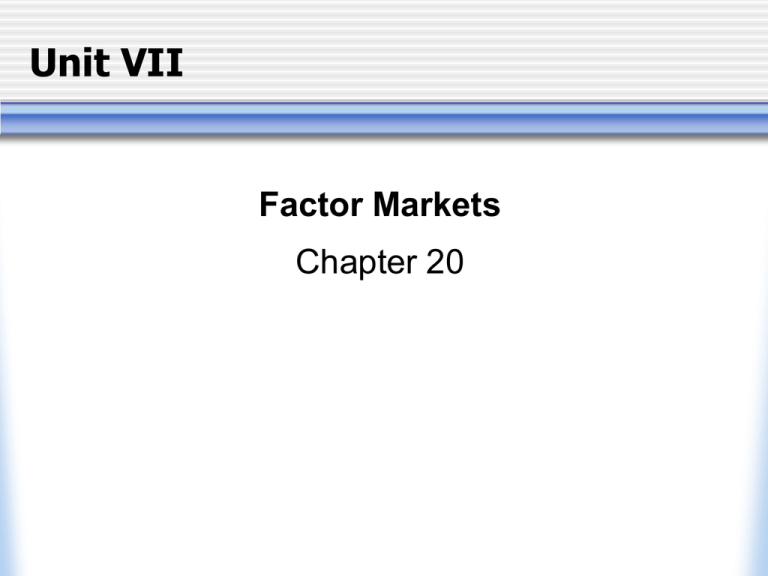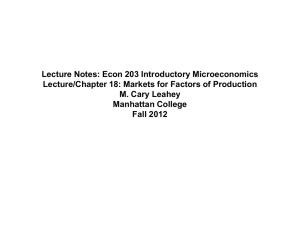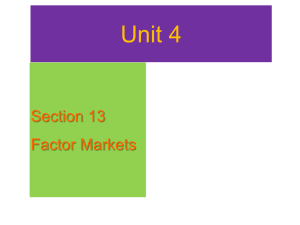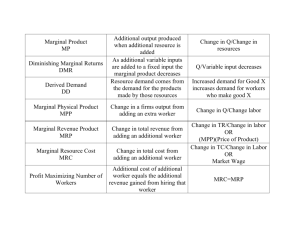Factor Markets: Labor, Capital, and Land
advertisement

Unit VII Factor Markets Chapter 20 In this chapter, look for the answers to these questions: • What determines a competitive firm’s demand for labor? • How does labor supply depend on the wage? What other factors affect labor supply? • How do various events affect the equilibrium wage and employment of labor? • How are the equilibrium prices and quantities of other inputs determined? Varied Markets Labor Markets Labor market – collection of people and firms who are trading labor services • Job – contract between a firm and a household to provide labor services Varied Markets Financial Markets • Capital – tools, instruments, machines, and other constructions that have been produced in the past and that businesses use to produce goods and services • Financial capital – funds that firms use to buy and operate physical capital Varied Markets (Financial cont.) • Financial Market – A collection of people and firms who are lending and borrowing to finance the purchase of physical capital. – The two main types of financial market are • Stock market • Bond market Varied Markets Stock Market • market in which the shares in the stocks of companies are traded – Examples: New York Stock Exchange, NASDAQ Varied Markets Bond Market • market in which bonds issued by firms or governments are traded Bond • promise to pay specified sums of money on specified date Anatomy of Factor Markets Land Markets • land consists of all the gifts of nature • market in which raw materials are traded are called a commodity market Competitive Factor Markets • most factor markets have many buyers and sellers and are competitive markets Factors of Production and Factor Markets • Factors of production: inputs used to produce goods and services – Labor – Land – Capital: equipment and structures used to produce goods and services • prices and quantities of these inputs are determined by supply & demand in factor markets Derived Demand • Markets for the factors of production are like markets for goods & services, except: – Demand for a factor of production is a derived demand • derived from a firm’s decision to supply a good in another market The Versatility of Supply and Demand (a) The Market for Apples (b) The Market for Apple Pickers Price of Apples Wage of Apple Pickers Supply P Supply W Demand Demand 0 Q Quantity of Apples 0 L Quantity of Apple Pickers The apple producer’s demand for apple pickers is derived from the market demand for apples. Two Assumptions 1. We assume all markets are competitive. The typical firm is a price taker – in the market for the product it produces – in the labor market 2. We assume that firms care only about maximizing profits – Each firm’s supply of output and demand for inputs are derived from this goal Our Example: Farmer Jack • Farmer Jack sells wheat in a perfectly competitive market • He hires workers in a perfectly competitive labor market • When deciding how many workers to hire, Farmer Jack maximizes profits by thinking at the margin: – If the benefit from hiring another worker exceeds the cost, Jack will hire that worker Our Example: Farmer Jack • Cost of hiring another worker: the wage – the price of labor • Benefit of hiring another worker: Jack can produce more wheat to sell, increasing his revenue • size of this benefit depends on Jack’s production function: the relationship between the quantity of inputs used to make a good and the quantity of output of that good Farmer Jack’s Production Function Q (bushels (no. of of wheat workers) per week) 3,000 Quantity of output L 2,500 0 0 1 1000 2 1800 3 2400 500 4 2800 0 5 3000 2,000 1,500 1,000 0 1 2 3 4 No. of workers 5 Marginal Product of Labor (MPL) • Marginal product of labor: the increase in the amount of output from an additional unit of labor MPL = ∆Q ∆L where ∆Q = change in output ∆L = change in labor The Value of the Marginal Product • Problem: – cost of hiring another worker (wage) is measured in dollars – benefit of hiring another worker (MPL) is measured in units of output • Solution: convert MPL to dollars • Value of the marginal product: the marginal product of an input times the price of the output VMPL = value of the marginal product of labor = P x MPL The Value of the Marginal Product VMPL = value of the marginal product of labor = P x MPL Sometimes referred to as Marginal Revenue Product or MRP. A C T I V E L E A R N I N G 1: Computing MPL and VMPL P = $5/bushel. Find MPL and VMPL, fill them in the blank spaces of the table. Then graph a curve with VMPL on the vertical axis, L on horiz axis. L Q (no. of (bushels workers) of wheat) 0 0 1 1000 2 1800 3 2400 4 2800 5 3000 MPL VMPL A C T I V E L E A R N I N G 1: Answers Farmer Jack’s L Q MPL = VMPL = production (no. of (bushels function workers) of wheat) ∆Q/∆L P x MPL exhibits 0 0 diminishing 1000 $5,000 1 1000 marginal 800 4,000 product: 2 1800 600 3,000 MPL falls as 3 2400 L increases. 400 2,000 This property is very common. 4 2800 5 3000 200 1,000 A C T I V E L E A R N I N G 1: Answers The VMPL curve Farmer Jack’s VMPL curve is downward sloping, due to diminishing marginal product. $6,000 5,000 4,000 3,000 2,000 1,000 0 0 1 2 3 4 L (number of workers) 5 Farmer Jack’s Labor Demand Suppose wage W = $2500/week. How many workers should Jack hire? Answer: L = 3 At any smaller larger L,L, can increase profit by hiring another one worker. fewer worker. The VMPL curve $6,000 5,000 4,000 3,000 $2,500 2,000 1,000 0 0 1 2 3 4 L (number of workers) 5 VMPL and Labor Demand For any competitive, profit-maximizing firm: – To maximize profits, hire workers up to the point where VMPL = W. – The VMPL curve is the labor demand curve. W W1 VMPL L1 L Demand for a factor of production The first two columns of the table are the firm’s total product schedule. To calculate marginal product, find the change in total product as the quantity of labor increases by 1 worker. Demand for a factor of production To calculate the value of marginal product, multiply the marginal product numbers by the price of a car wash, which in this example is $3. Demand for a factor of production Demand for a factor of production Previously we viewed the value of the marginal product at Max’s Wash ’n’ Wax. The blue bars show the value of the marginal product of the labor that Max hires based on the numbers in the table. The orange line is the firm’s value of the marginal product of labor curve. Recall from previous slides • A Firm’s Demand for Labor – firm hires labor up to the point at which the value of marginal product equals the wage rate – if value of marginal product of labor exceeds the wage rate, a firm can increase its profit by employing one more worker – if wage rate exceeds the value of marginal product of labor, a firm can increase its profit by employing one fewer worker This graph shows the demand for labor at Max’s Wash’n’ Wax. At a wage rate of $10.50 an hour, Max makes a profit on the first 2 workers but would incur a loss on the third worker. The demand for labor curve slopes downward because the value of the marginal product of labor diminishes as the quantity of labor employed increases. The Marginal Revenue Product of Labor The Relationship between the Marginal Revenue Product of Labor and the Wage WHEN … THEN THE FIRM … MRP > W, should hire more workers to increase profits. MRP < W, should hire fewer workers to increase profits. MRP = W, is hiring the optimal number of workers and is maximizing profits. Shifts in Labor Demand Labor demand curve = VMPL curve. W VMPL = P x MPL Anything that increases P or MPL at each L will increase VMPL and shift labor demand curve upward. D2 D1 L Things that Shift the Labor Demand Curve • Changes in the output price, P • Technological change (affects MPL) • The supply of other factors (affects MPL) – Example: If firm gets more equipment (capital), then workers will be more productive; MPL and VMPL rise, labor demand shifts upward The Connection Between Input Demand & Output Supply • Recall: marginal cost (MC) = cost of producing an additional unit of output = ∆TC/∆Q, where TC = total cost • Suppose W = $2500, MPL = 500 bushels • If Farmer Jack hires another worker, ∆TC = $2500, ∆Q = 500 bushels MC = $2500/500 = $5 per bushel • In general: MC = W/MPL The Connection Between Input Demand & Output Supply • In general: MC = W/MPL • Notice: – – – – To produce additional output, hire more labor As L rises, MPL falls causing W/MPL to rise causing MC to rise • Hence, diminishing marginal product and increasing marginal cost are two sides of the same coin The Connection Between Input Demand & Output Supply • The competitive firm’s rule for demanding labor: P x MPL = W • Divide both sides by MPL: P = W/MPL • Substitute MC = W/MPL from previous slide: P = MC • this is the competitive firm’s rule for supplying output • Hence, input demand and output supply are two sides of the same coin Labor Supply • People face trade-offs, including a trade-off between work and leisure: --the more time you spend working, the less time you have for leisure. • The cost of something is what you give up to get it. The opportunity cost of leisure is the wage. The Labor Supply Curve An increase in W is an increase in the opp. cost of leisure. People respond by taking less leisure and by working more. W S1 W2 W1 L1 L2 L Things that Shift the Labor Supply Curve • changes in tastes or attitudes regarding the labor-leisure trade-off • opportunities for workers in other labor markets • immigration Equilibrium in the Labor Market The wage adjusts to balance supply and demand for labor. The wage always equals VMPL. W S W1 D L1 L A C T I V E L E A R N I N G 2: Changes in labor-market equilibrium In each of the following scenarios, use a diagram of the market for auto workers to find the effects on the wage and number of auto workers employed. A. Baby Boomers in the auto industry retire. B. Widespread recalls of U.S. autos shift car buyers’ demand toward imported autos. C. Technological progress boosts productivity in the auto manufacturing industry. A C T I V E L E A R N I N G 2A: Answers The market for The retirement of Baby Boomer auto workers shifts supply leftward. W rises, L falls. autoworkers W S2 S1 W2 W1 D1 L2 L1 L A C T I V E L E A R N I N G 2B: Answers The market for A fall in the demand for U.S. autos reduces P. At each L, VMPL falls. Labor demand curve shifts down. W and L both fall. autoworkers W S1 W1 W2 D2 L2 L1 D1 L A C T I V E L E A R N I N G 2C: Answers The market for At each L, MPL rises due to tech. progress. VMPL rises and labor demand curve shifts upward. W and L increase. autoworkers W S1 W2 W1 D2 D1 L1 L2 L Productivity and Wage Growth in the U.S. time period growth rate of productivity growth rate of real wages 1959-2003 2.1% 2.0% 1959-1973 2.9 2.8 1973-1995 1.4 1.2 1995-2003 3.0 3.0 A country’s standard of living depends on its ability to produce g&s. Our theory implies wages tied to labor productivity (W = VMPL). We see this in the data. The Other Factors of Production • With land and capital, must distinguish between: – purchase price – the price a person pays to own that factor indefinitely – rental price – the price a person pays to use that factor for a limited period of time • wage is the rental price of labor • The determination of the rental prices of capital and land is analogous to the determination of wages… How the Rental Price of Land Is Determined Firms decide how much land to rent by comparing the price with the value of the marginal product (VMP) of land. The rental price of land adjusts to balance supply and demand for land. P The market for land S P D = VMP Q Q How the Rental Price of Capital Is Determined Firms decide how much capital to rent by comparing the price with the value of the marginal product (VMP) of capital. The rental price of capital adjusts to balance supply and demand for capital. P The market for capital S P D = VMP Q Q Rental and Purchase Prices • Buying a unit of capital or land yields a stream of rental income • rental income in any period equals the value of the marginal product (VMP) • Hence, equilibrium purchase price of a factor depends on both the current VMP and the VMP expected to prevail in future periods Linkages Among the Factors of Production • In most cases, factors of production are used together in a way that makes each factor’s productivity dependent on the quantities of the other factors • Example: an increase in the quantity of capital – The marginal product and rental price of capital fall – Having more capital makes workers more productive, MPL and W rise Markets for Labor • How does a college degree affect future earning? Equilibrium in the Labor Market • The Effect on Equilibrium Wages of a Shift in Labor Supply Labor and the Great Immigrations • In the early 20th century, wages rose as technological change increased the demand for labor enough to offset the increase in labor supply resulting from immigration. Differences in Wages • Baseball players are paid more than college professors. Explaining Differences in Wages • Compensating Differentials Higher wages that compensate workers for unpleasant aspects of a job • Discrimination (Economic) Paying a person a lower wage or excluding a person from an occupation on the basis of an irrelevant characteristic such as race or gender Non-perfectly competitive labor Markets • Monopsony Firm is a price maker and has the power to affect wages CONCLUSION • The theory in this chapter is called the neoclassical theory of income distribution • It states that – factor prices determined by supply and demand – each factor is paid the value of its marginal product • Most economists use this theory a starting point for understanding the distribution of income. CHAPTER SUMMARY • The economy’s income distribution is determined in the markets for the factors of production. The three most important factors of production are labor, land, and capital. • A firm’s demand for a factor is derived from its supply of output. • Competitive firms maximize profit by hiring each factor up to the point where the value of its marginal product equals its rental price. CHAPTER SUMMARY • The supply of labor arises from the trade-off between work and leisure, and yields an upward-sloping labor supply curve. • The price paid to each factor adjusts to balance supply and demand for that factor. In equilibrium, each factor is compensated according to its marginal contribution to production. • Factors of production are used together. A change in the quantity of one factor affects the marginal products and equilibrium earnings of all factors.








